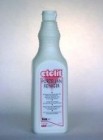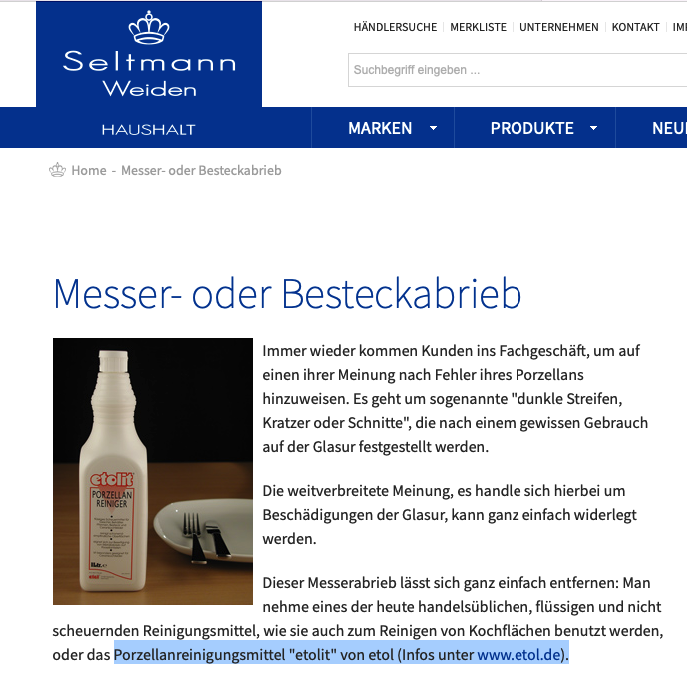Food residues

Solid residues that settle on the porcelain after prolonged use are not a manufacturing fault or quality defect. There are various causes of solid residue on porcelain, the most important of which are described here.
Solid residues from tap water
German tap water has an average hardness of 16.52° (source: wasserhaerte.net). Cologne has up to 24°, the Ruhr area around 18°, Hayerode in Thuringia even 30°d.H. If not used properly, these water hardnesses leave considerable mineral residues and crystalline deposits on the wash ware, which considerably increase cutlery abrasion or the formation of scratches on the glazes.
Solid residues due to chemicals
The use of chemical detergents and, in particular, their incorrect dosage, leave chemical residues on the wash ware and favour glaze corrosion.
Solid residues from tea and coffee
Tea and coffee contain essential and fatty oils, caffeine and alkaloids (teein). This mixture, heated thermally, forms a viscous lubricant that covers everything that comes into contact with it. It leaves lasting traces in pots and cups that can no longer be removed with conventional washing-up or cleaning agents. There is a widespread opinion that the porcelain has changed and the foreign substances have penetrated the glaze. This is definitely wrong! In countries with a strong tea culture, tea cups are never rinsed, only boiled.
Seen with the German eye, we find the typical Chinese tea bowls or Moroccan coffee cups unappetising and dirty! From a microbiological point of view, however, the residues of chemical washing-up liquids are far more dangerous than the visual residues of tea, fats and oils. Even the East Frisian tea connoisseur carefully wipes his cups with hot, clear water after rinsing. Just like the porcelain abrasion, all residues on the glaze can be removed with a porcelain cleaner (see picture). An old household recipe is also an effervescent tablet of Kukident denture cleaner: if you let it dissolve in the container, almost all residues on porcelain glazes are also removed with an efficiency of over 80%.
Solid residues due to inadequate drying
A common cause of the formation of mineral solids on the surface of porcelain is water droplets and water noses, which can be attributed to inadequate drying. There are many reasons for this. In combination with the above-mentioned residues in tap water, the residual moisture on crockery items provides ideal oases for long-term damage to porcelain and ceramic crockery.
Solid residues due to cutlery abrasion
Cutlery abrasion is also a solid residue on porcelain and settles on the glaze as fine metallic dust.
Removal of solid residues
(Image and text rights: Seltmann Porzellanfabrik/Germany)While many porcelain brands such as Seltmann Weiden (picture above - click to enlarge) and many others recommend "etolit" porcelain cleaners for removing solid residues, we take a critical and cautious view of the use of this method. The user should first of all be aware that using such a special cleaner only combats the symptom - i.e. the result of the formation of solids - and not the cause. Failure to take further measures to combat the causes of a build-up of solids will inevitably result in a new build-up of solids. The probability that other items of crockery will be affected in the future is therefore very high.
We at Holst Porzellan therefore recommend that you first investigate where and why solids have formed on porcelain.
Depending on the type and intensity of the unsightly damage (cutlery abrasion / scratches / glaze corrosion), as well as the material, price and value, special cleaning of the affected crockery item may or may not be advisable. In the case of low-fired ceramics, such special cleaners often lead to an undesirable deterioration of the visual condition. Vitreous ceramics, stoneware and New Bone China and all types of coloured decorations and solid colours cannot be restored to the desired original condition with such porcelain cleaners. There is probably a reason why etolit is called "porcelain cleaner" and not "ceramic cleaner".
Therefore, only use "etolit" and similar porcelain cleaners on genuine porcelain and leave out decorated surfaces. If you are unsure whether the item in question is genuine porcelain or not, please read our porcelain specifications. Take your time for the cleaning process and do not shorten it by applying more pressure. The higher the pressure, the faster you will damage the glaze. However, there are other tricks that may be better, faster or cheaper for removing solid residues.
- Light cutlery abrasion: Scrub porcelain firmly with a very hard root brush and a little washing-up liquid.
- Grease, oil, starch, tea stones and cutlery abrasion: Leave a commercially available denture cleaner (e.g. Kukident) to work for a longer period of time.
- Medium cutlery abrasion & other solids: Scrub with hot steam, root brush and a little washing-up liquid.
- Last solution: porcelain cleaner.
- Best solution: Buy new Holst porcelain!
Product knowledge - A request to our readers!
Since 1998, we have been cultivating our product knowledge out of a passion for porcelain and the endeavour to share our knowledge about this beautiful and exciting material. In more than 20 years, our information pages have grown into a free online encyclopaedia of porcelain knowledge and now serve as a helpful reference work for dealers, end customers, vocational schools and even competitors. In times of increasingly important reviews on the Internet, we therefore ask you to write us a small review on Google. This will help us to address topics that have not yet been dealt with and to constantly revise this knowledge database. Thank you very much.


